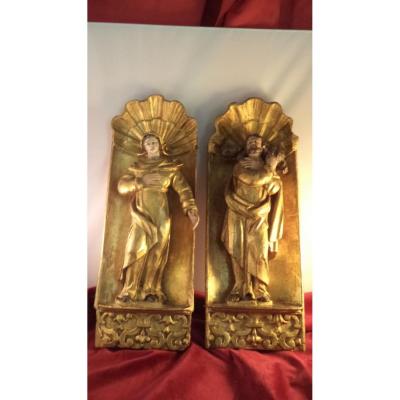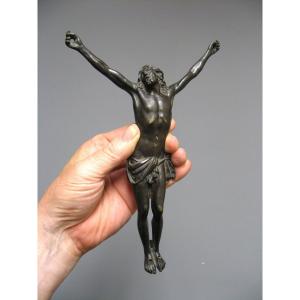Crucified Christ in carved ivory with traces of polychromy, placed with four diamond-tipped nails on a carved wooden Latin cross, simply decorated (ivory lines towards the outside of the crosspieces, engraved with two lines each). Jesus is depicted alive, raising and tilting his head to the side and looking towards the sky; the perizonium or purity cloth that covers his nudity is tied at the side, with fine folds and still retains traces of polychromy; the body has a slight movement thanks to a subtle contrapposto, thus counterbalancing the more static posture that is usually due to the presence of four nails. The face, framed by long curly hair and a beard, has a striking expressiveness and a remarkable quality and detail (teeth, tongue, eyebrows, pupils, etc.). From an iconographic point of view, the type of living or dying Christ to which this example belongs is frequent in Spanish (and European) Baroque sculpture, as is the recovery of the four nails for crucified Christs. As for the material, ivory has always been one of the most appreciated for small sculpture and other high-quality luxury objects. In centres such as Granada, it may have been the domain of the circle of Pablo de Rojas, Montañés, the García and Ocampo families, who were able to make works with this ivory. Compare this example with works such as the 17th-century Ivory Christ with Crown of Thorns from the Diocesan Museum of Tarragona, or the Crucified Christ marked Hedvi from the Cathedral of Badajoz (perhaps from the Spanish or French school, first half of the 18th century), or that of Beissonat from the Convent of the Encarnación in Madrid, as well as with other works from European schools.
It is CITES certified. Exportable only to the European Union.
Weight: 1.23 kg - Dimensions: 32x6x63 cm. Christ: 25x32 cms. Head of foot


















































 Le Magazine de PROANTIC
Le Magazine de PROANTIC TRÉSORS Magazine
TRÉSORS Magazine Rivista Artiquariato
Rivista Artiquariato